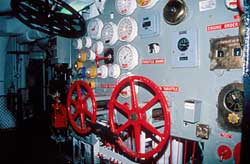
Located in Corpus Christi, Texas, the aircraft carrier USS Lexington (CV-16) participated in almost every major World War II naval campaign in the Pacific from 1943 to 1945. The ship was a highly decorated warship, receiving numerous citations acknowledging her exemplary service. As an Essex-class carrier, Lexington is also important for illustrating the development of aircraft carrier design, the refinement of multi-carrier operations, and the integration of aviation as a primary strike weapon in naval strategy. As early as 1910, the U.S. Navy, recognizing the potential value that flight would have in naval operations, appointed non-flyer Captain Washington Irving Chambers to keep informed of developments in aviation. Chambers worked closely with Glenn Curtiss, aircraft manufacturer Eugene Fly (an associate of Curtiss) and Lieutenant T.G. Ellyson, the first naval aviator (trained in aviation by Curtiss at no cost to the government) to demonstrate the advantages of aviation to the Navy. Although naval aviation was utilized during World War I, aircraft assigned to warships generally provided only reconnaissance support for the fleet.

The possibility of using planes as a naval strike weapon did not begin until the 1920s when aircraft capable of performing heavy bombardment against land or sea targets were built. Naval vessels capable of carrying several squadrons of such aircraft were developed concurrently. Thus the first eight carriers constructed by the U.S. Navy varied in size, speed, protection and aircraft complement in order to provide the greatest number of carriers capable of launching the greatest number of air strikes, yet still comply with treaty-imposed tonnage restrictions.Essex (CV-9), the ninth U.S. carrier authorized, was a product of these earlier designs. A total of 26 Essex-class carriers were ordered by the U.S. Navy between February 1940 and June 1943 and 24 were completed. This was the largest class of carriers ever built by the United States and over half, including Lexington (CV-16), served as part of the Pacific Fleet during World War II.
Prior to World War II, the Navy had no practical battle experience for its carriers. It was in the Pacific Theater that aircraft carrier operations were developed and refined. Serving as mobile air bases, carriers could maneuver aircraft around the open waters and scattered island chains of the Pacific. By employing a combination of scouting, fighter or bomber aircraft to control the enemy's air power, groups of carriers, screened by surface ships, could open the way for island invasions, cover and support amphibious operations, and help to hold the conquered areas. Thus carriers became an integral compound of nearly every campaign throughout the Pacific War. With aircraft that extended the fleet's firepower beyond the range of large caliber battleship guns, the carrier's status was elevated from reconnaissance platform to that of major surface combatant.

World War II and the carrier campaigns of the Pacific firmly established the role of aviation within naval operations and the aircraft carrier replaced the battleship as the Navy's primary strike weapon. With postwar advances in nuclear arms and jet propulsion, the Essex carriers were upgraded to facilitate these new weapons and aircraft. Thus with modifications, Lexington continued to serve through the Cold War where air power played an increasingly important role in the major wars and limited engagements of the period.
USS Lexington (CV-16) was launched in 1942 as a welded, steel hull, Essex-class aircraft carrier with an overall length of 872 feet and a length along the waterline of 820 feet. Lexington had hangar deck capacity for 103 aircraft. Lexington's first air group (AG-16), consisted of 89 aircraft that included 32 F6f-3 Hellcat fighters, 35 SBD-5 Dauntless dive-bombers and 18 TBF-1 Avenger torpedo bombers. On November 26, 1991 Lexington was decommissioned. After making the successful bid to preserve, display and interpret Lexington, the city of Corpus Christi, Texas prepared a new life for the carrier as a museum ship.
Visit the National Park Service Travel American Aviation to learn more about Aviation related Historic Sites.
Last updated: August 22, 2017
